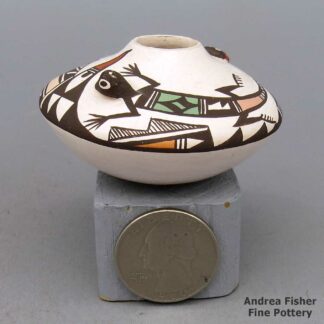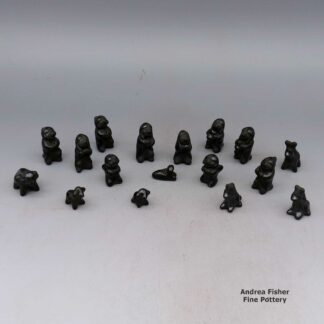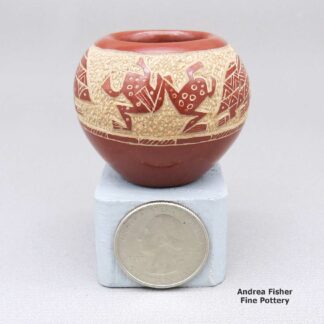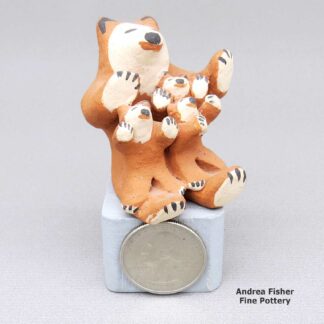Miniature
About Miniatures
Most people who have heard of it think miniature pottery has to be something new in the world of Native American pottery. In reality, archaeologists have found miniature pottery in the remains of ancient ruins in Chaco Canyon, Mesa Verde, across eastern Arizona, southern New Mexico and south to the Paquimé and Casas Grandes region in northern Mexico. Archaeologists working in the eastern US have found miniature pottery spread across Early Woodland Culture sites, too, dated up to 1700 years ago.
We have no idea as to why the ancients created miniature pottery but there's lots of speculation. Perhaps it was made as toys for children. Perhaps it was made by children learning to make pottery, and as their expertise grew, the size of their pieces grew, too. Perhaps it was made and placed in a firing pit as a good luck charm, hoping that other pots being fired in the pit would survive the firing process and not crack or break. Perhaps it was made for some ceremonial purpose we have no possibility of knowing. We do know that in North America, almost every pottery-making group of ancients made miniature pottery. They decorated it, too, just like the full size pottery the women of the time were making.
As the rebirth of traditionally made Native American pottery has unfolded over the last century, research into the ancient forms, styles and designs has also brought the miniature back into focus. There are more than a few potters these days making tiny gems again, similar to and, at the same time, more refined than the products of the potters of prehistory. And while some are still being made by children learning as they grow up, many more are being made by established adult potters. Some have made their entire careers around the making of miniatures while others sometimes make a few miniatures to complement the full range of forms and styles of full size pieces they make.
Since the advent of big trade fairs showcasing Native American pottery, the definition of what makes a miniature has evolved. In the beginning a miniature had no dimension larger than 2.25 inches. Then it was felt that that small a definition was too small: there was no competition because there were too few potters making pottery in that size range. Then one venue changed their definition to: no dimension larger than 4.25 inches, while another changed their definition to: no dimension larger than 3.25 inches. Competition for prizes in the different miniature styles rose immediately at both but it didn't answer the basic question: what is a miniature? As far as Thomas Natseway of Laguna Pueblo is concerned, a miniature has no dimension larger than 2.25 inches. And he's been making them smaller than that for more than 30 years.
Showing all 5 results
-

Carolyn Concho, lkac2l295: Miniature polychrome jar with applique and painted lizard, ladybug, and geometric design
$135.00 Add to cart -

Dorothy Gutierrez, lksc2l287: Black 17-piece miniature nativity set
$495.00 Add to cart -

Goldenrod, zzsc2m537, Red jar with a turtle and frog design
$375.00 Add to cart -

Kevin Naranjo, cjsc3c260, Miniature bowl with sgraffito design
$375.00 Add to cart -

Marie Romero, lcco3b105, Miniature bear storyteller with three cubs
$110.00 Add to cart
Showing all 5 results